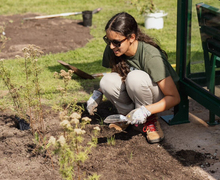New Orleans journalists heeded call to work despite city destruction
In an ancient Greek fable, a woman named Cassandra is cursed with the ability to predict the future, but no one believes her. In 2002, Mark Schleifstein’s series of stories predicted how a major hurricane could destroy New Orleans.
Three years later, one did.
‘There used to be houses there – not anymore,’ he said as he came upon a slide of New Orleans’ desolated ninth ward.
Schleifstein, a reporter with The New Orleans Times-Picayune along with Features Editor James O’Byrne and National Public Radio Editor Susan Feeney spoke at last night’s forum, ‘Hell and High Water: Covering Hurricane Katrina and Its Aftermath’ in Newhouse II.
Schleifstein’s stories, ‘Washing Away,’ predicted many of the failures that appeared with Katrina: the levees’ breach, difficulties evacuating and a death toll in the thousands. He and O’Byrne scrolled through slides with maps predicting different models of what would happen if a major hurricane hit New Orleans head-on.
O’Byrne was also infamously involved with Katrina. As the national media were declaring the city had ‘dodged the bullet,’ O’Bryne discovered the levees were breached across the city and quickly failing.
They came upon a slide titled ‘Hurricane Pam.’ This was a Federal Emergency Management Agency exercise from 2004 that detailed the response if a major hurricane struck the city.
‘FEMA knew,’ Schleifstein said with frustration. ‘Michael Brown (FEMA director at the time of Katina) was there.’
There’s a lot of frustration from both Schleifstein and O’Byrne. During the question portion of the event, they ripped into the federal government for building the doomed levy system and then standing helpless in the aftermath. When an NPR interview with Homeland Security Secretary Michael Chertoff was played, Schleifstein shook his head. He laughs, when the interview asks about what happened to FEMA’s plans for the emergency.
Soon after, they bring up a slide of one of the most iconic photos of the Katrina tragedy: a woman outside of the convention center screaming, ‘Help us, please.’ In the background sit more refugees of the storm, not reacting to her cries.
‘There’s a kind of numbness in these people,’ O’Byrne said. ‘They’ve felt betrayed by their country, and rightfully so.’
The numbness could just as easily apply to the reporters. They laugh when talking about their own houses’ destruction. They run through slide after slide of their city destroyed, narrating matter-of-factly with ‘used to be,’ ‘once was there’ and ‘now gone.’
Before the storm, while the city was evacuating, they stayed behind to cover the story.
‘I never considered leaving,’ Schleifstein said. ‘I expected to be sleeping under my desk just like every other storm.’
Unfortunately, for this storm, he would have to settle for sleeping under someone else’s desk. After the storm struck and the city began to flood, the Picayune moved to Houma and Baton Rouge, La., to continue producing the paper with reporters behind in New Orleans. O’Bryne described how he found himself in charge of the production side of the operation.
Without any authority to do so, he let the IT guy charge $21,000 worth of new computers and rented 30 cars from an Avis in Texas. Twenty-four hours, later they had a newsroom up.
‘I spent … I don’t know actually; they never told me how much I ended up spending,’ O’Bryne said.
The most profound part of Katrina as a journalist was when he came across 35 survivors who had been rescued earlier in the day from second-story windows and rooftops, O’Bryne said.
‘Thank God the Times-Picayune is here,’ they said to him. ‘Someone is going to tell our story.’
When Katrina struck, the journalists stayed along side the doctors, nurses and emergency workers.
‘Journalism is not accounting or banking; there’s an element of calling,’ O’Bryne said.
Both recounted stories of photographers rescuing people from there homes and reporters bringing supplies.
‘We knew there was danger,’ O’Bryne said, ‘but as long as there is a soul left in the city, you stay.’
Published on February 6, 2006 at 12:00 pm





